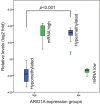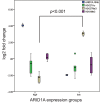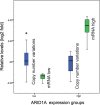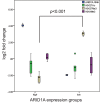Promoter hypermethylation of ARID1A gene is responsible for its low mRNA expression in many invasive breast cancers
- PMID: 23349767
- PMCID: PMC3549982
- DOI: 10.1371/journal.pone.0053931
Promoter hypermethylation of ARID1A gene is responsible for its low mRNA expression in many invasive breast cancers
Abstract
ARID1A (AT-rich interactive domain 1A) has recently been identified as a tumor suppressor gene. Its mRNA expression is significantly low in many breast cancers; this is often associated with more aggressive phenotypes. However, the underlying molecular mechanism for its low expression has not been fully understood. This study was undertaken to evaluate the contribution of gene copy number variation, mutations, promoter methylation and histone modification to ARID1A's low expression. 38 pairs of breast invasive ductal carcinomas and their normal breast tissue counterparts from the same patients were randomly selected for gene expression and copy number variation detection. Promoter methylation and histone modification levels were evaluated by MeDIP-qPCR and ChIP-qPCR, respectively. PCR product Sanger sequencing was carried out to detect the exon mutation rate. Twenty-two out of 38 invasive ductal carcinomas in the study (57.9%) revealed ARID1A mRNA low expression by realtime RT-PCR. The relative promoter methylation level was, significantly higher in ARID1A mRNA low expression group compared with its high expression group (p<0.001). In the low expression group, nineteen out of 22 invasive ductal carcinomas (86.4%) exhibited ARID1A promoter hypermthylation. In addition, the promoter hypermethylation was accompanied with repressive histone modification (H3K27Me3). Although five out of 38 invasive ductal carcinomas (13.2%) exhibited loss of ARID1A gene copy number by realtime PCR and nine exon novel mutations are seen from eight out of 33 invasive ductal carcinomas (24.2%), there was no statistically significant difference in both ARID1A mRNA low and high expression groups (p=0.25,and p=0.68, respectively). We demonstrate that promoter hypermethylation was the main culprit for ARID1A mRNA low expression in invasive ductal carcinomas. The influence of mutation and copy number variation on the expression were statistically insignificant at mRNA level, and were, therefore, not considered the main causes for ARID1A mRNA low expression in invasive breast cancer.
Conflict of interest statement
Figures






Similar articles
-
Frequent low expression of chromatin remodeling gene ARID1A in breast cancer and its clinical significance.Cancer Epidemiol. 2012 Jun;36(3):288-93. doi: 10.1016/j.canep.2011.07.006. Epub 2011 Sep 1. Cancer Epidemiol. 2012. PMID: 21889920
-
The promoter methylation status and mRNA expression levels of CTCF and SIRT6 in sporadic breast cancer.DNA Cell Biol. 2014 Sep;33(9):581-90. doi: 10.1089/dna.2013.2257. Epub 2014 May 19. DNA Cell Biol. 2014. PMID: 24842653 Free PMC article.
-
Promoter hypermethylation and BRCA1 inactivation in sporadic breast and ovarian tumors.J Natl Cancer Inst. 2000 Apr 5;92(7):564-9. doi: 10.1093/jnci/92.7.564. J Natl Cancer Inst. 2000. PMID: 10749912
-
Molecular and pathological landscape of the AT-rich interaction domain 1A (ARID1A) mutation in hepatocellular carcinoma.Pathol Res Pract. 2025 Feb;266:155763. doi: 10.1016/j.prp.2024.155763. Epub 2024 Dec 9. Pathol Res Pract. 2025. PMID: 39706068 Review.
-
Roles of ARID1A variations in colorectal cancer: a collaborative review.Mol Med. 2022 Apr 14;28(1):42. doi: 10.1186/s10020-022-00469-6. Mol Med. 2022. PMID: 35421925 Free PMC article. Review.
Cited by
-
ARID1A is involved in DNA double-strand break repair in gastric cancer.J Gastrointest Oncol. 2024 Jun 30;15(3):862-872. doi: 10.21037/jgo-24-283. Epub 2024 Jun 27. J Gastrointest Oncol. 2024. PMID: 38989399 Free PMC article.
-
Prognostic Significance of ARID1A Expression Patterns Varies with Molecular Subtype in Advanced Gastric Cancer.Gut Liver. 2023 Sep 15;17(5):753-765. doi: 10.5009/gnl220342. Epub 2023 Feb 15. Gut Liver. 2023. PMID: 36789575 Free PMC article.
-
Loss of Tumor Suppressor ARID1A Protein Expression Correlates with Poor Prognosis in Patients with Primary Breast Cancer.J Breast Cancer. 2015 Dec;18(4):339-46. doi: 10.4048/jbc.2015.18.4.339. Epub 2015 Dec 23. J Breast Cancer. 2015. PMID: 26770240 Free PMC article.
-
Low ARID1A Expression is Associated with Poor Prognosis in Hepatocellular Carcinoma.Cells. 2020 Sep 1;9(9):2002. doi: 10.3390/cells9092002. Cells. 2020. PMID: 32878261 Free PMC article.
-
ARID1A knockdown enhances carcinogenesis features and aggressiveness of Caco-2 colon cancer cells: An in vitro cellular mechanism study.J Cancer. 2022 Jan 1;13(2):373-384. doi: 10.7150/jca.65511. eCollection 2022. J Cancer. 2022. PMID: 35069887 Free PMC article.
References
-
- Decristofaro MF, Betz BL, Rorie CJ, Reisman DN, Wang W, et al. (2001) Characterization of SWI/SNF protein expression in human breast cancer cell lines and other malignancies. J Cell Physiol 186: 136–145. - PubMed
-
- Wang X, Nagl NG Jr, Flowers S, Zweitzig D, Dallas PB, et al. (2004) Expression of p270 (ARID1A), a component of human SWI/SNF complexes, in human tumors. Int J Cancer 112: 636. - PubMed
Publication types
MeSH terms
Substances
LinkOut - more resources
Full Text Sources
Other Literature Sources
Medical

